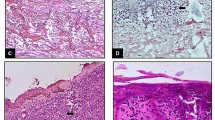Abstract
A total of 117 vital skin wounds (post infliction intervals between a few seconds and 7 months), 20 postmortem wounds and skin specimens with beginning or advanced signs of putrefaction were investigated. Different markers for macrophage maturation (27 E 10, RM 3/1, 25 F 9, G 16/1) were analyzed by immunohistochemistry. The early stage inflammation marker 27 E 10 stained macrophages, but also monocytes and neutrophilic granulocytes localized in blood vessels or bleeding induced postmortem and therefore provided no further information for a forensic wound age estimation in comparison to the routine histological detection of macrophages. The antigens recognized by the RM 3/1- (intermediate stage inflammation marker) and 25 F 9-antibodies (late stage inflammation marker) were expressed exclusively by histiocytes and inflammatory cells that had migrated from the blood vessels as part of the acute inflammatory response associated with an intravital reaction. The morphometrical analysis revealed positive results (defined as at least a two-fold increase in number in 2 or more microscope fields when compared to the maximum value of histiocytes found in uninjured skin) for the RM 3/1- or 25 F 9-antibody earliest in wounds aged 7 or 11 days, respectively. Similarly to the 25 F 9-antibody, the chronic stage inflammation marker (G 16/1) reacted with a macrophage subpopulation first detectable 12 days after wounding but showed positive results in a comparably reduced percentage of cases. On the other hand, this marker did not stain a relevant number of resident macrophages thus facilitating the evaluation of the specimens. The markers 27 E 10, RM 3/1 and 25 F 9 are also useful for the evaluation of slightly - even though the staining intensity was considerably reduced - but not advanced putrefied skin. Therefore, the immunohistochemical analysis of the corresponding antigens can possibly contribute to an age estimation of wounds with advanced post infliction intervals obtained from corpses with longer - but limited - postmortem intervals.
Zusammenfassung
Insgesamt wurden 117 vitale Hautwunden (Überlebenszeit wenige Sekunden bis 7 Monate), 20 postmortal gesetzte Verletzungen sowie Haut mit leichten bzw. fortgeschrittenen Fäulnisveränderungen untersucht und verschiedene Marker der Makrophagen-Differenzierung (27 E 10, RM 3/l, 25 F 9 und G 16/1) analysiert. Der „early stage inflammation marker” 27 E 10 färbte neben Makrophagen auch Monozyten und neutrophile Granulozyten, die innerhalb von Blutgefäßen bzw. in postmortal gesetzten Blutungen lokalisiert waren und liefert somit keine Informationen zum Wundalter, die über die Möglichkeiten des Routine-histologischen Nachweises von Makrophagen hinausgingen. Die von den Antikörpern RM 3/1 (intermediate stage inflammation marker) und 25 F 9 (late stage inflammation marker) erkannten Antigene wurden ausschließlich von Histiozyten und reaktiv eingewanderten Makrophagen exprimiert. Die morphometrische Analyse ergab positive Ergebnisse (definiert als ein mindestens zweifacher Anstieg der Zellzahl in zwei oder mehr Gesichtsfeldern verglichen mit der maximal feststellbaren Zahl an Histiozyten in unverletzter Haut) bei Verwendung der Antikörper RM 3/1 bzw. 25 F 9 frühestens 7 bzw. 11 Tage nach Wundsetzung. Ab 12 Tagen Wundalter reagierte der „chronic stage inflammation marker” G 16/1 erstmals positiv. Das Antigen ließ sich insgesamt allerdings in einem geringeren Prozentsatz der untersuchten Wunden darstellen. Vorteilhaft ist jedoch das Fehlen einer relevanten Expression durch Histiozyten, wodurch die Auswertung der Präparate erleichtert wird. Die entsprechenden Antigene lassen sich zudem in leicht - wenn auch in einer deutlich geringeren Färbeintensität -, aber nicht forgeschritten fäulnisveränderter Haut nachweisen, so daß deren immunhistochemische Darstellung gegebensfalls auch zur Beurteilung von länger überlebten Verletzungen an Leichen mit etwas fortgeschrittener Liegezeit herangezogen werden kann.
Similar content being viewed by others
References
Betz P (1994) Histological and enzyme histochemical parameters for the age estimation of human skin wounds. Int J Leg Med 107: 60–68
Betz P, Nerlich A, Wilske J, Tübel J, Wiest I, Penning P, Eisenmenger W (1992) The time-dependent rearrangement of the epithelial basement membrane in human skin wounds - immunohistochemical localization of collagens IV an VII. Int J Leg Med 105: 93–97
Betz P, Nerlich A, Wilske J, Tübel J, Penning R, Eisenmenger W (1993) The time-dependent reepithelialization of human skin wounds - immunchistochemical localization of keratins 5 and 13. Int J Leg Med 105: 223–227
Bhardwaj RS, Zotz C, Zwadlo G, Roth J, Goebeler M, Mahnke K, Falk M, Meinhardus-Hager G, Sorg C (1992) The calciumbinding proteins MRP 8 and MRP 14 form a membrane associated heterodimer in a subset of monocytes/macrophages present in acute but absent in chronic inflammatory lesions. Eur J Immunol 22: 1891–1897
Broecker EB, Zwadlo G, Suter C, Brune M, Sorg C (1987) Infiltration of primary and metastatic melanomas with macrophages of the 25 F 9-positive phenotype. Cancer Immunol Immunother 25: 81–86
Broecker EB, Zwadlo G, Holzmann B, Macher E, Sorg C (1988) Inflammatory cell infiltrates in human melanoma at different stages of tumor progression. Int J Cancer 41: 562–567
Eisenmenger W, Nerlich A, Glück G (1988) Die Bedeutung des Kollagens bei der Wundaltersbestimmung. Z Rechtsmed 100: 79–100
Goldstein J, Braverman M, Salafia C, Buckley P (1988) The phenotype of human placental macrophages and its variation with gestational age. Am J Pathol 133: 648–659
Hsu SM, Raine C, Fanger H (1981) A comparative study of the peroxidase-antiperoxidase method and an avidin-biotin-complex method for studying polypeptide hormones with radio immunoassay antibodies. Am J Clin Pathol 75: 734–739
Oehmichen M (1990) Die Wundheilung. Springer, Berlin Heidelberg New York
Zwadlo G, Broecker EB, Bassewitz DB, Feige U, Sorg C (1985) A monoclonal antibody to a differentiation antigen present on human macrophages and absent from monocytes. J Immunol 134: 1487–1492
Zwadlo G, Voegeli R, Schulze Osthoff K, Sorg C (1987) A monoclonal antibody to a novel differentiation antigen on human macrophages associated with the down-regulatory phase of the inflammatory process. Exp Cell Biol 55: 295–304
Author information
Authors and Affiliations
Rights and permissions
About this article
Cite this article
Betz, P., Tübel, J. & Eisenmenger, W. Immunohistochemical analysis of markers for different macrophage phenotypes and their use for a forensic wound age estimation. Int J Leg Med 107, 197–200 (1995). https://doi.org/10.1007/BF01428405
Received:
Revised:
Issue Date:
DOI: https://doi.org/10.1007/BF01428405




